Dichondra was once considered a weed, but in contemporary gardens is used as a flowering alternative to lawns. Its tough build and vigorous spreading habit make it an ideal substitution for traditional grass lawns.
To grow this dramatic ground cover at home, follow some simple steps in our guide below, and don’t just stick to the common native species, why not branch out and try some of the variegated or gorgeously red-toned dichondra varieties at home?
More...
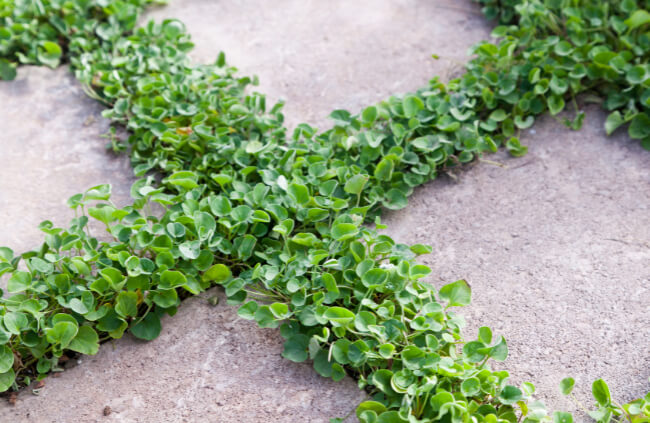
Family: | Convolvulaceae |
|---|---|
Genus: | Dichondra |
Species: | Various |
Common Name: | Ponysfoot |
Origin: | Global, Dichondra repens are native to Australia |
Location: | Outdoor |
Type: | Groundcover |
Growth: | 0.5cm (H), spreading ground cover |
Sun requirements: | Full sun or part shade |
Foliage Colour: | Green |
Flower Colour: | White |
Flowering: | Spring and summer |
Fruits: | None |
Maintenance level: | Low |
Poisonous for pets: | Non-toxic to cats and dogs |
What is Dichondra?
Dichondra is a prostrate perennial groundcover plant that holds its leaves all year round on soft herbaceous stems. In spring and summer, it produces masses of pretty white flowers, and can be trimmed and edged just like grass lawns for neat surfaces, or left to spread through cracks in paths and pavement to soften routes through your garden.
How is Dichondra used in gardens?
Dichondra is most commonly used as a lawn alternative, sown directly onto prepared soil, or planted as plugs to establish more quickly. However, it's also useful in rockeries and as a weed suppressant ground cover plant.
Dichondra loves poor soil and can rot into cracks in rocks, or even brick mortar, so can be used as a ground cover plant around trees and shrubs without taking nutrients, and is incredibly effective at blocking weeds.
For the same reason, you should avoid planting dichondra in ornamental herbaceous beds, where it can prevent herbaceous plants, or self-seeded annuals, from resurfacing in spring.
Natural Habitat of Dichondra
Dichondra repens is native to Australia and New Zealand, though the genus is widespread and grows naturally all over the world. It prefers temperate conditions, where it can truly thrive as a ground cover plant, but will cope well with droughts and tropical conditions in equal measure.
Best Dichondra Varieties to Grow, and How to Use Them
There are around twenty recognised species of Dichondra, but just five are practical to use in gardens, either because they are easier to control, more durable, or produce a better-looking mat of foliage and flower.
The other species are quite sparse, and spread rapidly in most conditions, swamping small shrubs, so stick to the five below to maintain neat and manageable ground cover, with the added bonus of sweet and delicate flowers.
1. Dichondra repens (Lawn Leaf)Lawn leaf, the common D. repens, and the most common native dichondra in Australia and New Zealand is the easiest dichondra to cultivate from seed or plug plants, and will quickly establish in lawns and borders, or even as wall cover if plugged into gaps in mortar, and watered well. Its star-shaped flowers are rife in spring and summer and are self-deadheading so will continue to pop up in patches across your lawn - noticeably patterned based on the morning shadow. Check out our full growing guide for Dichondra repens for more info about this variety. | 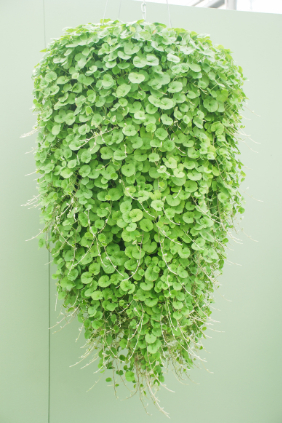 |
2. Dichondra argentea (Silver ponysfoot)D. argentea is native to desert regions of the United States, and most prevalent in Texas, where it thrives in drought conditions with very little water, producing heavy matts of green in otherwise arid landscapes. As our climate gets warmer and drier in summer, silver ponysfoot may well be a necessity, rather than a choice, when it comes to rethinking our lawns in warmer parts of Australia. Refer to our in-depth guide to growing Dichondra argentea to see if this is the variety for you. | 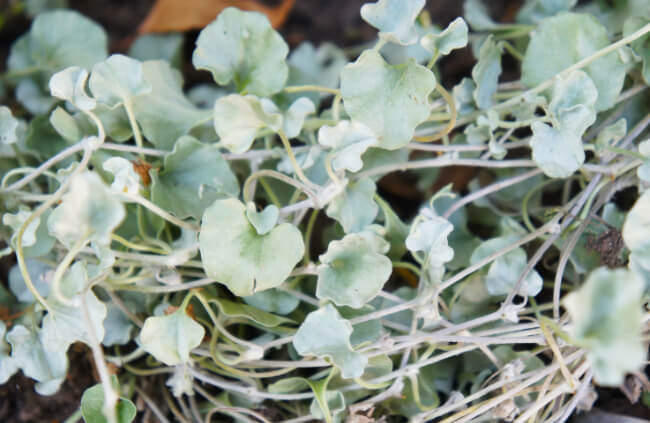 |
3. Dichondra microcalyxThe larger leaves of D. microcalyx aren’t neat enough to use as lawns, and tend to be more sprawling, so are borderline invasive, but for brave gardeners looking to reduce the self-seeded annual weeds in their garden, it is a gorgeous spreading ground cover plant that prevents unwanted germination around your borders. Depending on your soil it will either produce large, emerald green foliage, followed by white campanulate flowers, or textured silver-green foliage that adds a textured depth around the base of shrubs, or even draped down from hanging baskets. | 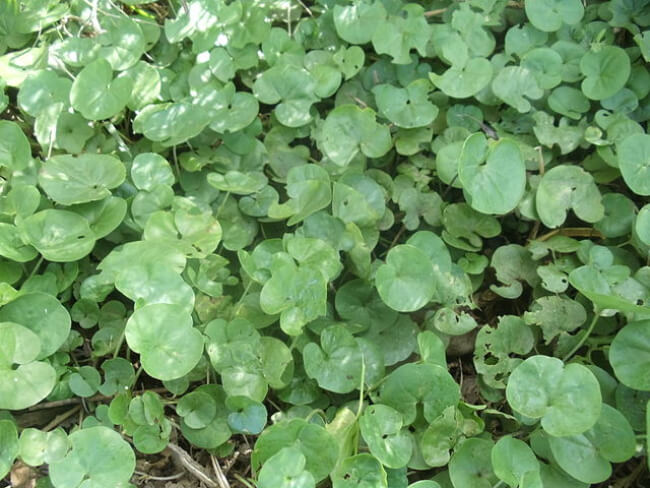 Source: Wikispecies - Wikimedia |
4. Dichondra brachypodaOne of the most changeable and interesting Dichondra species for gardens is another American native, found naturally in New Mexico, but happy to grow in most parts of the world. D. brachypoda is slower to establish than most, but together too. If you’re happy to wait, it will eventually become a truly stunning lawn plant in most conditions, but is best used on walls as an alternative to ivy, as it lays with perspective, making your garden feel bigger with visual trickery. | 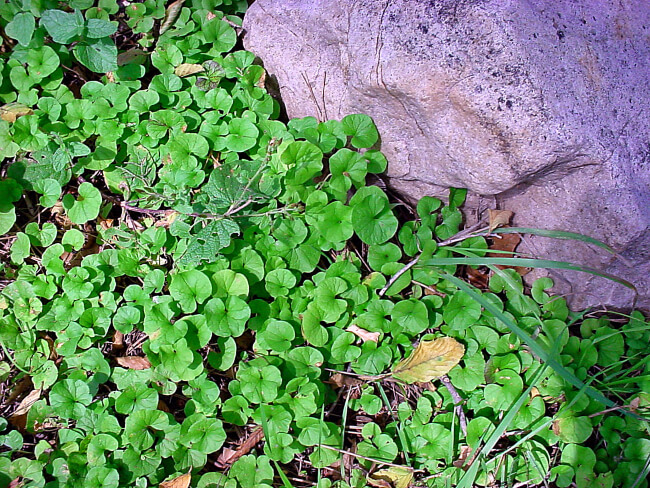 Source: Wnmu.edu |
5. Dichondra occidentalis (Western ponysfoot)D. occidentalis, with its wrinkled and sparse foliage isn’t a practical lawn alternative, but it is a beautiful plant in its own right. Grown in cracks in bricks, pavements, or paths, it will quickly establish dense ground cover in small areas, but given more space it sends longer shoots that thrust ahead relentlessly creating naked patches of earth. In spring and summer, the flowers are small but mighty, with deep red centres and a crisp white fringe. | 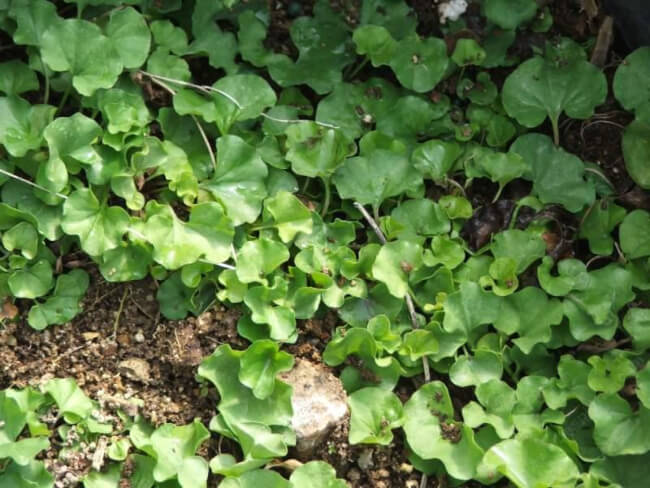 Source: Las Pilitas Nursery |
Best Dichondra Varieties to Grow, and How to Use Them
There are around twenty recognised species of Dichondra, but just five are practical to use in gardens, either because they are easier to control, more durable, or produce a better-looking mat of foliage and flower.
The other species are quite sparse, and spread rapidly in most conditions, swamping small shrubs, so stick to the five below to maintain neat and manageable ground cover, with the added bonus of sweet and delicate flowers.
1. Dichondra repens (Lawn Leaf)

Lawn leaf, the common D. repens, and the most common native dichondra in Australia and New Zealand is the easiest dichondra to cultivate from seed or plug plants, and will quickly establish in lawns and borders, or even as wall cover if plugged into gaps in mortar, and watered well.
Its star-shaped flowers are rife in spring and summer and are self-deadheading so will continue to pop up in patches across your lawn - noticeably patterned based on the morning shadow.
Check out our full growing guide for Dichondra repens for more info about this variety.


Get Your Free Guide:
Master Growing Australian Natives eBook
A Must Have Complete Guide for Every Australian Garden
Get Your Free Guide:
Master Growing Australian Natives eBook
A Must Have Complete Guide for Every Australian Garden
2. Dichondra argentea (Silver ponysfoot)

D. argentea is native to desert regions of the United States, and most prevalent in Texas, where it thrives in drought conditions with very little water, producing heavy matts of green in otherwise arid landscapes.
As our climate gets warmer and drier in summer, silver ponysfoot may well be a necessity, rather than a choice, when it comes to rethinking our lawns in warmer parts of Australia.
Refer to our in-depth guide to growing Dichondra argentea to see if this is the variety for you.
3. Dichondra microcalyx

Source: Wikispecies - Wikimedia
The larger leaves of D. microcalyx aren’t neat enough to use as lawns, and tend to be more sprawling, so are borderline invasive, but for brave gardeners looking to reduce the self-seeded annual weeds in their garden, it is a gorgeous spreading ground cover plant that prevents unwanted germination around your borders.
Depending on your soil it will either produce large, emerald green foliage, followed by white campanulate flowers, or textured silver-green foliage that adds a textured depth around the base of shrubs, or even draped down from hanging baskets.
4. Dichondra brachypoda

Source: Wnmu.edu
One of the most changeable and interesting Dichondra species for gardens is another American native, found naturally in New Mexico, but happy to grow in most parts of the world. D. brachypoda is slower to establish than most, but together too.
If you’re happy to wait, it will eventually become a truly stunning lawn plant in most conditions, but is best used on walls as an alternative to ivy, as it lays with perspective, making your garden feel bigger with visual trickery.
5. Dichondra occidentalis (Western ponysfoot)

Source: Las Pilitas Nursery
D. occidentalis, with its wrinkled and sparse foliage isn’t a practical lawn alternative, but it is a beautiful plant in its own right.
Grown in cracks in bricks, pavements, or paths, it will quickly establish dense ground cover in small areas, but given more space it sends longer shoots that thrust ahead relentlessly creating naked patches of earth.
In spring and summer, the flowers are small but mighty, with deep red centres and a crisp white fringe.
How to Grow Dichondra in Australia
Growing dichondra is a simple process. You can start the process by sowing seed thinly across a raked bed of free-draining earth, or plant plug plants 1 ft apart, and wait for them to connect.
Both methods will take a full summer to knit together into a usable lawn.
Soil pH & Drainage Requirements
Dichondra will grow in exceptionally poor soil, provided it is more acidic than alkaline (ideally with a pH of 5.5 to 6.5). If growing from seed indoors, ready for plug plants to plant into the lawn area, use an inter substrate like coconut coir compost, and keep it moist until it germinates.
Just like sowing a lawn, it is important to keep newly sown dichondra lawns well watered for their first few weeks, until they germinate, and begin to spread. After that, they are fine to be left alone.
Light requirements of Dichondra
D. repens can be grown in full sun or part shade, so is ideal for most garden conditions, even if your lawn is shaded by the house for part of the day, or by large trees.
Most other dichondra varieties require baking summer heat and arid conditions to thrive, so do best in full sun in any part of the country.
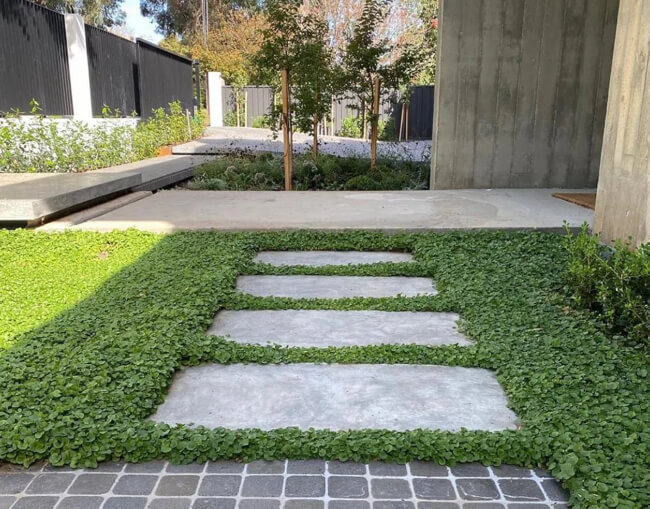
Source: Plant Tiles Australia
Growing a Dichondra lawn
The only challenge to growing a dichondra lawn is over-watering. Damp roots and excess moisture held in the soil will quickly lead to root rot. Obviously, as dichondra is a vigorous plant, it can heal over any damaged patches if you remove the rotten sections, but to begin with, it’s important to allow the soil to dry out between watering.
Once established, you don’t need to do anything, ever. Dichondra lawns will keep to a maximum height of 3cm, so all you have to do is trim around the edges with a hoe a few times a year to stop it from rooting outside the lawn boundary.
How to Grow Trailing Dichondra
Trailing dichondra like Silver ponysfoot are beautiful hanging basket plants. They can be used equally well for lawns, but are stunning when used in hanging baskets with other flowering plants, with the main benefit of helping to cover the soil and retain water for other plants, while taking very little nutrition away from other plants.
Use any low-nutrient growing medium to fill a container, or even holes in walls, and sow dichondra directly into the soil. In a few weeks, it should germinate, and then you just need to keep it gently moist for a few weeks until it roots firmly.
How to Propagate Dichondra

Source: Ball Seed
It’s probably harder not to propagate dichondra than to propagate it. If that sounds too good to be true, I understand, but it really is easy. Seeds will take in nearly any medium or conditions; cuttings will try to root in water, sand, gravel, or anywhere it stays still for long enough, and divisions can root even if you don’t get all of the roots.
In short, these plants are desperate to grow and will do so just about anywhere.
Dichondra Pests and Diseases
Dichondra don't have many pests, but in the US they suffer extensively from Dichondra flea beetles, and similar flea beetle species in Australia can be devastating, causing huge patches of lawn to wilt and die back within a few months.
Flea beetles prefer dry conditions, so water more frequently if you notice them, or suspect they are present.
Dichondra can suffer from most common fungal plant infections, like leaf spot, botrytis, southern light, powdery mildew and root-rot. Most are easy to prevent, and simple to treat simply by removing any visible signs when you see them, but some, like root rot or rust, are harder to definitely diagnose, and can therefore go unnoticed.
If you do spot patches of dry, yellow, orange, or crisp dichondra, particularly with damp soil at its base, there is likely a drainage problem or a problem with your irrigation. Reduce watering, and allow the soil to dry out.
If the problem doesn't resolve, dig out that section of lawn, and attempt to address the poor drainage before replanting.
Dichondra Frequently Asked Questions
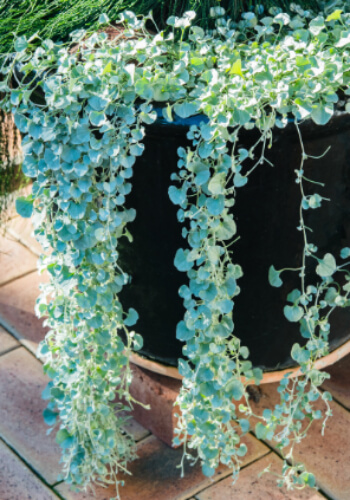
Can you overwater dichondra?
The most common cause of any fungal problem for dichondra is overwatering. Avoid watering dichondra at all in winter, and in summer, water once a week even in drought conditions, as it is very capable of coping with arid deserts, and a few weeks in the summer sun in your garden isn’t even close to that level of abuse.
Do silver falls come back every year?
Dichondra argentea, or silver falls, is tender in cool climates but happy to stay outdoors in most parts of Australia. Even some sheltered parts of Tasmania can sustain hanging baskets of Silver Falls through winter, provided it doesn’t freeze for more than a few days at a time.
Is dichondra a clover?
While an established dichondra lawn shares some similarities with clover it is completely unrelated, and when it flowers it becomes very obvious that the two are from separate botanical families.
Is dichondra good or bad?
Dichondra might seem too good to be true, and in many ways it is. For some, this fast-spreading ground cover plant is seen as unruly, and they’re not wrong, but provided you care for it with the same level of attention you would a traditional grass lawn, it will be easy to manage.
Is dichondra toxic?
Dichondra is not toxic to humans or animals. Quite the opposite. This clever ground cover plant is used to treat everything from jaundice to dysentery and is used in modern medicine as well as traditional herbal remedies. If you have sensitive skin, excessive contact with foliage can cause rashes.
Grow Beautiful Dichondra Lawn Today
Dichondra is an old-school alternative to lawns, but is having a huge resurgence in recent years thanks to climate-related necessity as much as desire. But it's not just about mitigating climate change, it's good for wildlife in other ways too.
As a flowering lawn, it offers pollen for bees and other insects, and increased biodiversity more generally in the garden, encouraging birds and other wildlife that feed on the increased pollinator population.
So there you have it. I’m officially a convert. If, like me, you want to try out new dichondra varieties, I hope we’ve helped you out. And if you’re not ready for a full lawn, make the most of this easy-to-grow pollinator-friendly trailing plant in tubs and baskets.
Published on June 13, 2023 by Maisie Blevins
Last Updated on February 23, 2025





Is there a way to get weeds out of dichondra?
Hi Jarrad,
Yep, but I’m going to guess it’s not the answer you’re looking for (sorry). Pretty much every weedkiller (spray, powder, DIY hack, etc.) will kill Dichondra too. Depending on the weeds you can adjust your lawn treatment to limit weed germination.
For example, if you stop watering, the dichondra will cope, but annual weeds will struggle to germinate or compete.
And if you go over any protruding (large-leaved) weeds with a lawn mower with the blades lifted higher than the dichondra every few weeks, you’ll stunt the growth of things like dandelions, which and prevent them from flowering (eventually that will get rid of them).
But the best way is to just get down on your knees with a thin weeding tool (I use a flat-head screwdriver) and try to prise out each individual weed, roots and all.
So in short, yes, there are many ways to get weeds out of dichondra, but it’s not effortless.
Best regards,
Massie Blevins